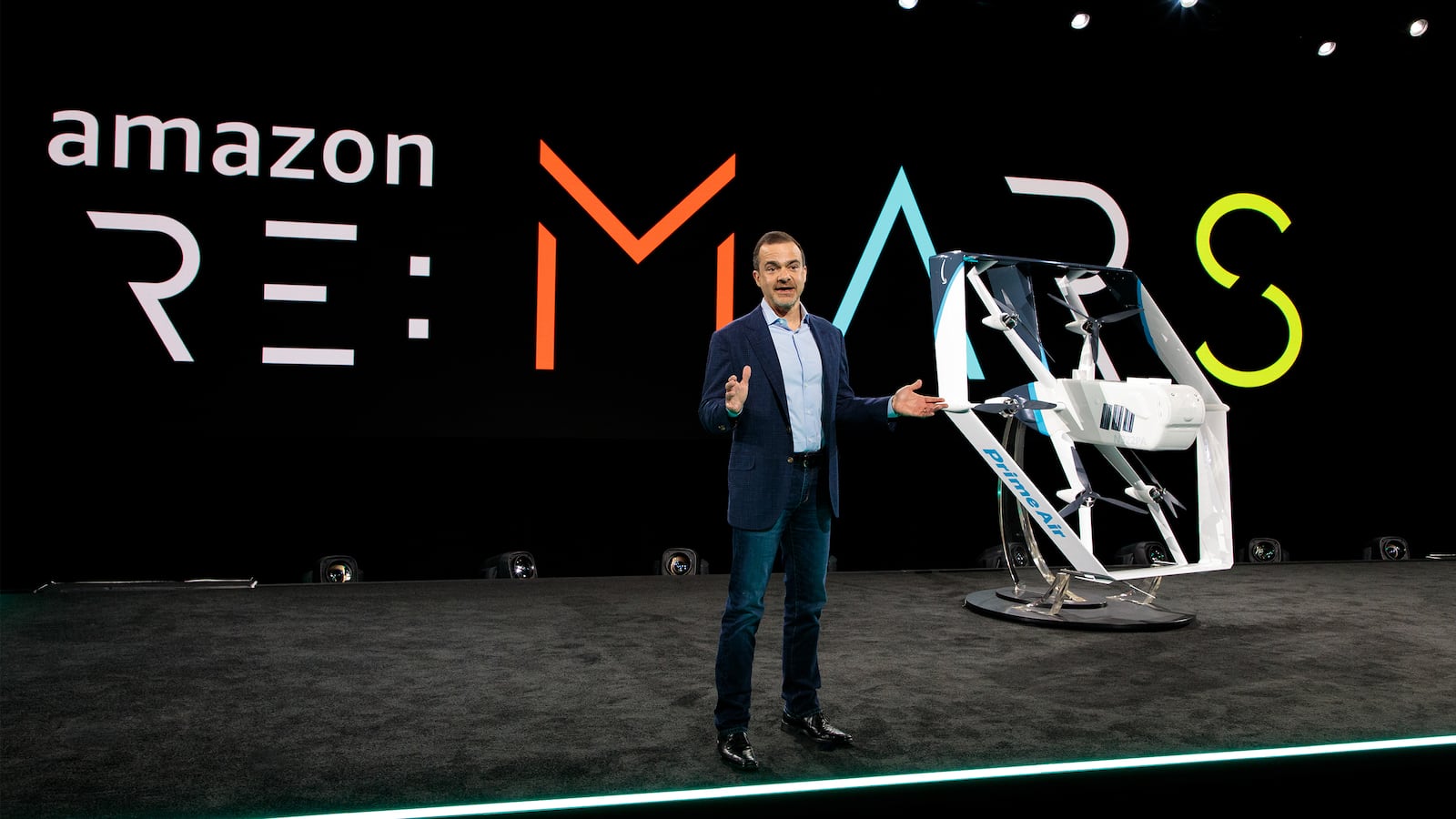Amazon has quietly been building an army of increasingly sophisticated flying robots for years and now the technology is starting to come into focus.
With a vast network of retail stores, fulfillment centers, and the deep resources necessary to get such an ambitious business off the literal ground, Amazon is gearing up to dominate the most futuristic corner of the on-demand economy.
The race to be the first U.S. company delivering packages via drone took a new turn earlier this summer, when Amazon’s Worldwide Consumer chief Jeff Wilke unveiled the company’s latest drone model at an event in Las Vegas. He pledged that Prime Air, Amazon’s drone delivery program, would be delivering packages to customers “in months.”
Within weeks of Wilke’s announcement, Amazon, Uber and UPS applied for air carrier certificates from the U.S. Federal Aviation Administration to launch commercial drone operations. In April, Wing Aviation, the drone delivery arm of Google’s parent company Alphabet—and a competitor to Amazon’s own aspirations—became the first American company granted FAA approval for commercial delivery.
Amazon describes its drone delivery business as “a future delivery system” with the stated goal of getting packages to customers in 30 minutes or less. “Prime Air has great potential to enhance the services we already provide to millions of customers by providing rapid parcel delivery that will also increase the overall safety and efficiency of the transportation system,” the company wrote in a summary of the program.
Amazon appears to be throwing more resources into its drone aspirations than its competitors, which makes sense given that drone delivery could be very advantageous to Amazon’s core business.
Since last summer, Prime Air has more than quadrupled the number of job listings on its website to nearly 170, according to Thinknum, a data analytics company that tracks changes to websites.
Wing currently has about 40 job openings and Uber lists a handful of jobs related to drone delivery. A UPS spokesperson said the company isn’t ready to share hiring information.
The bulk of Amazon’s open posts are located in Seattle, with a handful in Israel, Austria, California, France, Boston, and Cambridge, England, where the company showcased its first trial drone delivery to a customer in 2016.
AMAZON ABROAD
If Amazon receives FAA approval for its latest drone system, which can take anywhere from months to years, the company can prove its technology by flying in designated areas and scale up operations accordingly.
"If Amazon delivered to two customers within 12 months of Wilke’s announcement they would not have lied to anybody,” said Gerald Van Hoy, a drone-centric technology analyst at the Analyst Syndicate.
Van Hoy is skeptical that Amazon or its competitors will be flying in and around American suburbs, let alone urban areas, anytime soon.
“You’re more likely to get a package from Scout than from drones in congested traffic areas,” he said, referring to Amazon’s sidewalk-roaming delivery bot that’s currently making trial deliveries in the Seattle area and southern California.
Given the pace of regulatory approval in the U.S., he argues the company is more likely to make its first drone deliveries to customers abroad.
Amazon has made much more progress working with regulators in the United Kingdom, where it also has a vast network of fulfillment centers and retail stores packed with products ready to ship.
Still, the U.S. market is where most of the American companies have focused their efforts.
“You can put a man on the moon with enough resources, time and effort,” said Steve Luxion, executive director of the Alliance for System Safety of UAS through Research Excellence (ASSURE).
ASSURE is working with about two dozen research universities to help the FAA develop the basic rules and policies governing nationwide drone use.
But creating such a framework of rules–similar to the system that governs airplanes–could take more than a decade. In the meantime, companies can request waivers to launch limited operations, as Amazon, UPS and Uber recently did. If they can prove the safety of their technology, as Wing did in April, the FAA awards the waiver.
“If they want to devote the resources to it, I can pretty assuredly tell you they will get there before we clear the capability for the entire nation,” he said.
AMAZON'S ADVANTAGE
Tom Forte, senior research analyst at investment banking firm D.A. Davidson, sees Amazon as the dominant leader in the U.S. drone race.
Given the costly logistics of delivering customer orders at an ever faster pace, Amazon has a greater need for drones than the other companies, he said.
UPS lacks the technological expertise to master drone delivery, Forte said, arguing that the delivery giant was pulled into the drone race in 2013, when Amazon founder and CEO Jeff Bezos announced his plans to deliver packages by drone in less than 30 minutes during a 60 Minutes interview.
Uber is the most business- and tech-savvy of Amazon’s drone delivery competitors, according to Forte, but Amazon’s vast network of rural fulfillment centers, suburban sortation centers and its growing urban retail footprint give it a clear advantage in the race to build a booming drone business.
Google’s Wing may have been the first to gain FAA approval for commercial operations, but the Google subsidiary has approached drone delivery more as “a scientific problem to solve than a business play” according to Forte.
“Drones can be seen as a component of Amazon’s master plan of logistics,” Forte added.
Amazon has hinted at that master plan over the years. The company’s drone-centered patents have illustrated a future in which drones launch from delivery trucks, trains, and ships. One patent even showed drones being deployed from a snack-filled Amazon Prime Air blimp hovering over a sports arena. The company has also patented methods for syncing the drones with autonomous vehicles of all sorts.
And though many patents never come to life, one Amazon drone vision depicts a beehive-shaped fulfillment tower in a futuristic urban center, buzzing with flying robots making deliveries. Inside, robotic arms load packages onto the drones, while other robots restock shelves of inventory offloaded by autonomous trucks or repair damaged drones. The occasional human is pictured monitoring the robots.






